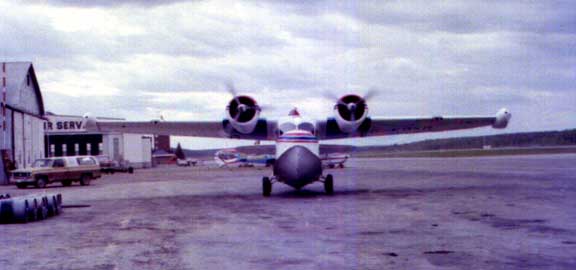 |
|
Grumman Goose |
| FTLComm - Watson Lake Yukon - Wednesday, November 28, 2001 |
| At one time the West Coast of North America was home to more than a dozen of these
flying boats. They first went into production in 1932 and the last were made in
1946. Fitted with six passenger seats, two 450hp Pratt&Whitney radial engines
and the ability to operate from a runway, lake or on the ocean. They had a gross
weight of four tons and sat empty at 5,425 pounds. With 220 U.S. gallons of fuel
they had a range of 640 miles and cruised at 191mph. This one was photographed on the Watson Lake runway in August of 1982 and was a Canadian operated aircraft. Seen here as a land aircraft the stabilising floats are retracted up to the wing tip but for water landings they were swung down. My only trip in one of these things was especially memorable. I boarded it in Port Hardy for a trip to Bella Bella in May of 1986. You enter the aircraft through the port side hatch which is an oval affair. Once inside the thing looks very much like something from a World War II movie. Seats along the side by each of the windows and room for luggage by the hatch. I chose a seat forward port side with the wheel wells in front of me. I could peer up into the cockpit and see the basic instruments that have sent aircraft aloft since the beginning and the floor column steel semicircular control wheel. The Pratts came to life with the kind of awareness that clobbers your whole body and long after the aircraft has left you in the distance that sound will stay with you for the rest of that day at least. There were about six Grumman Goose operating out of Port Hardy in 1986, three were with BCAir and had very spiffy white paint jobs. One day I dropped into the BC Air hangar and observed a mechanic working on the nose of one of this machines. The bow had been caved in and it looked very much like it had been rammed into a rock. The mechanic explained that this boat had just hit a "rogue" wave that smashed in the forward section of the bow but the machine had remained water tight and returned safely to base. The artillery barrage from start up to taxi was loud, and under no circumstances would anyone get used to that. I found it particularly unsettling to notice that as we taxied for departure I could look out through the gear wells and watch the runway moving by. The Grumman Goose has more power than most aircraft and lifts its tail and becomes a smooth flying bird in a moment or two. It climbed easily above the strait below and in ten minutes we were descending into a cove, the tires nicely tucked up into the passenger compartment and the wing tip floats hanging below the wings on their two braces. I am not a water pilot and the Goose hit the water with a kind of rat-ta-ta-tat as it skipped along, mercifully the Pratts slowed and the aircraft made the transition to water craft. Idling up to a dock, the hatch was popped open two loggers got off, with a few boxes and the artillery opened up again and the boat became a speedboat then left the water behind and joined the seagulls. One more water landing and then into the strip at Bella Bella. Today no Grumman Geese are registered as still in service in Canada. I have seen them in video so I know that some are still taking off and landing in the Caribbean There is a PT6 McKinnon version with two 650hp turbines that are still being used but the days of the noisy flying boat have ended in Canada. |
 |